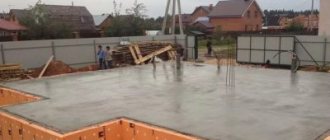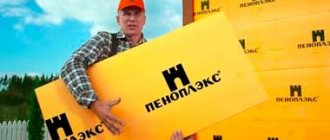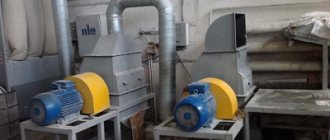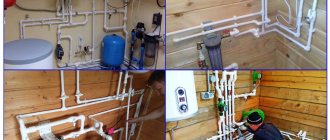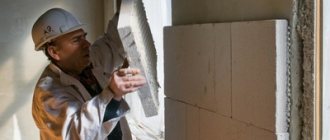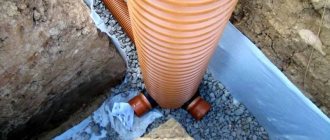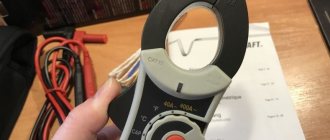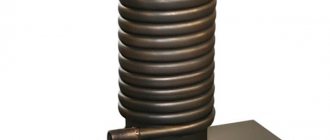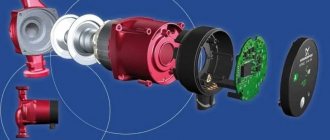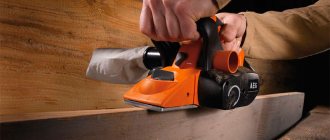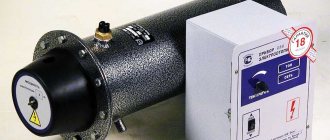We all know very well that the microclimate in the room, our comfort, as well as the financial resources used for heating depend on how well the home is insulated. In order not to end up in the role of the Jumping Dragonfly, who had a lot of fun in the summer, and then found herself in an extremely delicate situation, you need to prepare in advance for the harsh winter.
Of course, for economic men, all buildings are filled with firewood, coal and other types of fuel (with the exception of gasified dwellings). It would seem that you can sit in a rocking chair with a cup of herbal tea (or something stronger) and enjoy the charming landscapes outside the window or the flames dancing in the fireplace. Job done, time to relax!
But it was not there. Why? Have you insulated your house or will you heat the entire street, spending impressive sums on fuel? No? So, let's talk about modern insulation materials, or rather about one of them.
There are a number of different insulation materials designed for roofs, foundations, ceilings, walls and floors. Recently, sprayed thermal insulation has enjoyed great success in the construction market. You can also hear the expression “PPU insulation”. Let's discuss its advantages, disadvantages and areas of application.
Possibility of using foam fillers
Balloon thermal insulation , although better than its analogues in all respects, was not widely used in the past due to its high cost. And the use of such insulation was limited by the need to use special equipment, which, due to its price and complexity of development, is practically inaccessible outside the professional sphere. Much simpler and more profitable, although not always more convenient, was the use of mineral wool and polystyrene boards, which are made by extrusion.
Then manufacturers began to produce sprayed insulation in compact-sized cylinders, which led to a reduction in the cost of the method. To spray such a mixture of steel, complex installations and specialists in thermal insulation finishing are not needed, since the material itself is filled into small containers and the possibility of manual spraying is provided. Each cylinder is designed to cover one square meter of base (layer up to 60 mm thick). One person can process up to one hundred square meters per day.
As a result, calculations showed that working with insulation such as Polyno
r is much more profitable in terms of labor costs , costs for the materials themselves and surface preparation.
If a professional team of workers charges up to one and a half thousand rubles for insulating one square of wall, then using Polinor insulation with the same amount of material, you need to spend only about 500 rubles. You can work independently, which eliminates the need to look for experienced workers, reduces finishing time, and saves money. The choice of thermal insulation of this type remains the only optimal option that is available to people without special training. Foam can be used to create insulation for foundations, basements, walls inside and outside buildings made of brick, stone, concrete, and blocks. This option is also suitable for thermal insulation of non-load-bearing coatings, including floors on joists, as well as pitched roofs and attic floors.
Since Polinor is suitable for application to bases made of almost any material, it can be used as thermal insulation for plumbing fixtures and sewer pipes or fittings. In such cases, foam insulation in cylinders can be used indoors or in open areas. There is only one limitation on the use of balloon thermal insulation, which is that the material cannot be used to foam voids. It can only be applied to a dense base.
Thickness of applied layer
To insulate the wall, it is enough to apply a thermal insulation layer 50 mm thick.
However, it will not be possible to spray over the entire surface with such precision. Therefore, professionals advise working within the range of 50-60 mm, where the minimum thickness of the thermal layer is 50 mm, the maximum is 60 mm. Foam that protrudes strongly beyond the sheathing is cut off with a knife. The data is given for a brick wall of one and a half bricks. In all other cases you need to count. To do this, you can use an online calculator (see here) or do the calculations yourself.
Insulation density
The density can be adjusted simultaneously in several ways: by changing the proportions of the components, within hundredths of a percent, by the speed and force of foam supply. Therefore, it will not be difficult for an experienced specialist to adjust the equipment to the required density. And for walls it is about 40 kg/m3.
Material characteristics
Polyurethane foam (PPU) looks like a homogeneous structure of foam material, consisting of air bubbles filled with gas. Various versions of polyurethane foam are deservedly popular because they can be manufactured directly on the construction site. The most common method is to apply the material to the surface by spraying. Spraying is used for thermal insulation of houses, industrial workshops, pipelines, and in addition, it is actively used in the interior of premises.
Filling is used when it is necessary to fill a cavity between walls or a gap between installed finishing layers.
The thermal conductivity coefficient of the material is 0.023-0.025 W/mS. Teplis heat insulator is lightweight and can be easily applied to surfaces made of any materials (concrete, brick, glass, wood, aluminum, PVC).
Thanks to the optimal ratio of open and closed cells in the structure, the insulation “breathes”. Accordingly, the treated surface always remains clean and dry.
Other product benefits include:
- resistance to temperature changes;
- environmental friendliness;
- duration of operation (at least 20 years);
- seamless application, eliminating the formation of cold bridges;
- good sound insulation;
- low flammability;
- immunity from harmful rodents and insects.
Teplis polyurethane insulation is sold in 1 liter cylinders. Included with this product, the manufacturer offers to purchase a mounting gun with nozzles for uniform spraying.
Basement of a house with sprayed insulation applied
Main technical indicators
Foam thermal insulation in all respects is much better than conventional insulation materials , since its technical characteristics are comparable to industrial samples sprayed by pneumatic units. These basic parameters of Polynor include the following items:
- thermal conductivity in the range of 0.023−0.025 W/μ;
- density of the material after hardening - more than 28 kg/m³;
- vapor barrier at 70%, which is similar to “Izospan V”;
- moisture absorption - up to 2% (immersion in water at a temperature of about +100 ºС for 1.5 hours);
- maximum operating temperature - up to +121 ºC with an exposure time of up to one year;
- material life without reduction in technical characteristics - at least 50 years;
- environmentally friendly and suitable for use in residential premises.
Sprayed thermal insulation in cylinders withstands mechanical deformations (up to 50%) while maintaining volume and without destruction or loss of a given shape.
Insulation can be applied to surfaces made of metals (aluminium/cast iron/steel), brick, concrete structures, wood materials (plywood, boards) with adhesion at a level of 1−2.5 kg/cm². At the same time, sprayed thermal insulation in cylinders is resistant to humidity and chemicals in the form of organic solvents, oils, and soap solutions. The ingress of methyl chloride, dichloroethane, and hydrochloric acid leads to swelling, and sulfuric or nitric acid completely destroys the structure of the insulation.
Description and characteristics
Polinor is produced in a liquid state and applied to the surface by spraying. This popularity of the material is not caused by chance, because it is characterized by the following advantages:
- Fast drying. The surface becomes hard after 1 hour.
- Unaffected by rodents and insects.
- Does not form cold bridges.
- Does not harm the human body.
- There is no need to buy expensive equipment for application.
- The material is characterized by high efficiency.
- Has a long service life.
- The structure of the material is closed cells that do not allow water or steam to pass through.
- The material is self-extinguishing if there is no direct influence of fire.
In the photo - liquid insulation in cylinders Polinor
Polinor is not without its disadvantages, which include:
- A surface made of Polinor is resistant to direct influence of UV rays and constant contact with water, and the process of applying the material must take place at a temperature of 15-25 degrees.
- When working with insulation, you must adhere to safety rules using a mask and respirator.
Compared to existing analogues of liquid thermal insulation for walls, Polinor insulation is significantly different. First of all, the changes concern the structure, or more precisely, the percentage of open and closed cells in the solid mass. This criterion is very important, as it affects the level of thermal conductivity, moisture absorption and water permeability. Using Polinor, you can get about 70% of the cells, while when using similar sprayed products, the number of closed-type cells will be only 30-40%. However, it cannot be used as a seal for interior doors.
On the video, liquid insulation in cylinders Polinor:
The material in question has the lowest thermal conductivity among all the insulation materials that are available on the domestic market today. For example, mineral wool has a thermal conductivity coefficient of 0.045, expanded polystyrene – 0.033, and Polinor – 0.023 W/m2* °C. Thanks to these properties of the heat insulator, it is possible to reduce its consumption. One cylinder will be enough to treat 1.2-2.0 m2.
Sprayed thermal insulator Polinor can be applied at temperatures from -25 to +125 °C. If it is exposed to a temperature of 450 degrees, then its length will be deformed by 85%, and damage by weight will be 50%. The duration of its independent combustion will be 5 minutes.
Polinor is an environmentally friendly insulation material, thanks to which it can be used when arranging a residential building. The material has high adhesive properties to various surfaces, resistance to moisture, chemicals and aggressive environments.
Minuses
When deciding to use polyurethane foam in cylinders for thermal insulation of your home, you must also take into account its disadvantages:
- Low resistance to sunlight. It is recommended to paint, plaster or panel the finished surface, thereby protecting it from the damaging effects of ultraviolet radiation.
- The need for special protection. You need to work with the material wearing waterproof gloves and a respirator.
- Expensive. Such insulation is an order of magnitude more expensive than conventional roll or slab materials.
- Ability to smolder. Although polyurethane foam is a fireproof material, it is better to avoid direct exposure to open flames. During smoldering, the substance emits carbon monoxide, which is dangerous to humans.
- Low mechanical stability. The frozen layer must be protected from impacts and sharp tools. Almost all popular insulation materials have a similar disadvantage.
Liquid foam
This type of insulation includes almost all foam materials based on polymer resins. The quality of the final product, including its environmental friendliness, largely depends on them. There are raw materials whose use is not permissible for residential premises due to the high toxicity of the polymer and its long-term emissions. At the same time, such materials are quite suitable for insulating technical structures or isolated building elements (if there is confidence in their insulation and the conscientiousness of the working specialists).
At the moment, such types of liquid foam as polyurethane foam, penoizol, as well as a number of products in compact cylinders are common.
Polyurethane foam (PPU)
Viscous heterochain polymers in a liquid state are used as the main component of this insulation. During chemical reactions, urethanes foam, which leads to their increase in volume by more than 50 times.
In its frozen state, polyurethane foam resembles ordinary polyurethane foam, the main difference in the structure is less porosity.
Mainly used for:
- Insulation of walls of frame buildings;
- Roofing structures;
- House facades;
- Thermal insulation of basements and lower floors.
To apply polyurethane foam, you need a special unit that first mixes and foams the insulation components, and then delivers the finished mixture under pressure to the surface to be treated.
Final polymerization occurs within 24 hours, after which the finishing can be installed. Polyurethane foam is suitable for treating surfaces made of brick, concrete, wood, metal, cinder blocks and gas silicate blocks.
The average cost of work including material is 1000-1500 rubles per m2 , with a layer thickness of 50 mm.
Penoizol
A budget analogue of polyurethane foam insulation, since it is based on relatively cheap, but more toxic urea-formaldehyde resin. The structure of this insulation is very similar to ordinary foam plastic, but its use is more preferable due to the absence of cold gaps in the insulating layer, characteristic of sheet and roll materials.
The density of penoizol, even in a liquid state, is noticeably lower than its urethane analogues, which does not allow its use in loaded structures. Otherwise, the scope of application is similar to polyurethane foam. Thermal insulation qualities are also not exceptional and are comparable to mineral wool, and two times less than that of the polyurethane foam described above.
Apply under pressure after pre-mixing the components and foaming. Increases in volume by no more than 30 times relative to the original mixture.
Roof insulation with foam insulation
Work together with the material costs approximately 2000 rubles per 1 cubic meter .
Polyurethane foam
The products are mainly used for processing seams between insulation elements. Polyurethane foam is relevant as a means for sealing structures; it is also used for fastening building and finishing materials to the base being constructed. In terms of operational characteristics, the resource has an average level of efficiency. Do-it-yourself polyurethane foam for insulating the walls of a house is produced in small containers; the products are presented in a wide variety of models. When applied, the composition expands 20 times. The material is easy to use independently; even an amateur can handle the job.
Polyurethane foam
Building materials in this category are attractive due to their versatility. Polyurethane foam as thermal insulation demonstrates a high level of efficiency. The PU foam composition has excellent properties of resistance to aggressive environmental influences. After foaming, the primary production volume increases 40 times. The presence of many microbubbles in a two-component compound determines the exceptionally low thermal conductivity coefficient of this foam insulation. The use of polyurethane foam for wall insulation involves significant costs, since the composition is applied using special equipment. The service life of polyurethane foam reaches 50 years.
Polyurethane foam for wall insulation
"Polinor"
This is a liquid insulation based on polyurethanes. A common form of release is small cylinders, similar in appearance to those for polyurethane foam. Using one cylinder you can insulate about 1 m2 of surface with a layer thickness of 6-7 cm.
The strength and thermal insulation qualities are similar to polyurethane foam, but unlike it, “Polinor” is more suitable for household use, since it does not require special equipment for application. The relatively high cost (about 500 rubles per cylinder ) makes its use inappropriate over large areas.
The insulation is applied by spraying, which allows it to be used on almost any surface, for example, for thermal insulation of pipelines located outdoors.
As for filling voids in the walls, this procedure cannot be completed due to insufficient pressure in the cylinder.
"Polinor" has the following technical characteristics:
- Thermal conductivity – 0.025 W/(m*K);
- Moisture absorption coefficient – no more than 0.03;
- No toxicity, non-flammable;
- Solid density – not less than 28 kg per m3;
- Retains all operational properties for 50 years;
- The operating temperature should not exceed +121°C;
In addition, the mixture is quite chemically stable and does not interact with most reagents common in everyday life.
Chloroform, dichloroethane, and high concentration hydrochloric acid have a negative effect (promote swelling) on Polinor. Nitric and sulfuric acids react with polyurethane, thus destroying the insulating mixture as a whole. Current prices for your city:
The best manufacturers of polyurethane foam
The ranking of well-known manufacturers of polyurethane foam is headed by brands that have earned recognition in the construction industry.
Soudal
The brand has factories in Poland, Belgium and Slovenia. Soudal brand products provide a structure that meets high European standards and a good yield volume. The sealant does not darken or deform over time, and the durability of the product is impressive.
Krimelte
The manufacturer from Estonia (Penosil brand) offers a variety of models of polyurethane foam for various purposes. Krimelte products are known in the professional environment for their decent price-quality ratio.
Titan
The Orion brand, with production facilities in Turkey, Spain and Poland, ranks third in the popularity rating among polyurethane foam suppliers. Products of this brand foam well without secondary expansion.
Moment of installation
The products of a well-known brand are in demand due to their decent quality and availability of solutions.
Ultima
The brand produces good quality polyurethane foam, the products are easy to use. Judging by consumer reviews, the sealant of this brand does not have an acceptable level of efficiency.
Foam for wall insulation
Axton
The company produces a sealant with high odorless polymerization characteristics, while reviews indicate low adhesion and high porosity of the structure.
Titan02
The highly popular mounting foam Titan02 is available in a winter version and with increased fire resistance. The product demonstrates exceptionally high efficiency when installing window and door structures. It is actively used in the repair of utility systems, sealing and thermal insulation of buildings. Titan02 sealant is sold within 230 rubles.
Penosil
The product is distinguished by its density and uniformity of structure with a large output volume. It is used for installation of structures, filling seams and cavities of varying complexity. The model range also includes special versions for foam plastic. The cost varies from 220 rub.
Receiving PPU
When mixed, polyol and isocyanate produce foam, which increases in volume and then hardens. During the manufacturing process, it is necessary to adhere to a number of requirements: maintain the required temperature and mix all components well, which makes it possible to obtain a polyurethane output that does not have seals and large air cavities.
If you change the production method, you get polyurethane foams that differ in their basic characteristics. Some are better suited for insulating openings for doors and windows, others for brick and panel buildings or pipelines. By changing the proportions of the ingredients, when mixing them, polyurethane foam with different cell sizes is obtained.
The most popular materials in this group are the following:
- Foam rubber. It is widely used in everyday life and is familiar to every person. It is used as an upholstery filler for upholstered furniture and lining material.
- Rigid polyurethane foam is used when performing installation work. It has been noticed that this insulation is negatively affected by acids and solvents.
Instead of an epilogue
An analysis of the domestic market for modern sprayed insulation materials has revealed that it is largely represented by Russian manufacturers. The reason for this situation is the simple production technology of such substances, as well as the economic inexpediency of importing foreign analogues. Practice shows that Russian samples are in no way inferior to Western and Asian ones, and in most cases they are simply superior to them. Moreover, they are equally suitable for small household and large-scale industrial work. The diversity of this market is also not subject to criticism - there are a great many models and choosing an option for a specific task and at an adequate price is not difficult. However, it is worth mentioning that retail is far from being saturated with industrial-grade compounds that are useful during construction work. In most cases, such compositions are mixed by professionals themselves in order to maintain the required proportions for the final layer.
DIY application technology
Applying liquid insulation does not require any professional skills or expensive equipment (with the exception of liquid foam). To work, you will need a roller (brush or spray). When using a roller, you will also need a container to evenly rub the mixture over its surface. The process itself includes the following steps:
- We prepare the surface (clean the walls from excess mortar, sweep with a brush and wash with water).
- We prepare the material (if necessary, dilute it to the desired consistency).
- Pour paint into the roller container.
- Dip the roller in paint and roll it out on a special area until the mixture evenly saturates the roller.
- We carefully apply the insulation to the wall, no need to press hard. The first layer is applied from bottom to top.
- Subsequent layers are applied after complete polymerization of the first, usually after 24 hours (to find out the exact values, see the instructions for the insulation).
When drying any of the layers, it is necessary to avoid getting them wet, since most liquid thermal insulators are water soluble. Because of this, the impact of water on insulation that has not completely hardened can cause its complete or partial removal from the surface.
Application technology - video instructions:
Consumption per 1 m2
As noted in the advantages, this insulation is quite economical. The consumption of polyurethane foam in cylinders is as follows: 1 liter is enough to cover a wall of 1 m2 with a layer 4 cm thick. For comparison, when working with mineral wool, you will need to spend more. In addition to the material, additional elements are needed for insulation, that is, sheathing, fasteners, etc., which also costs money.
Required layer thickness
It all depends on the region in which the object is located. For clarity, there is a table that indicates how thick the layer should be for a specific element.
Quality test of produced thermal insulation spraying
Among professional craftsmen, it is always customary to test the quality of the applied polyurethane foam insulation. Every 40 square meters, a special knife is used to cut the coating and check its thickness relative to the expected one. Next, the density of the substance is checked in the laboratory. In addition, when spraying the substance in a thin layer, its layer-by-layer application can provide the most effective result. It is taken into account that such a procedure allows for an increase in density due to free foaming. It is worth noting that the higher the qualification of the specialist, the more evenly he sprays the foam, which allows for better insulation and avoids unnecessary consumption of the substance. Standard indicators for determining a quality layer are from 3 to 5 millimeters for every 50 square centimeters.
Features of insulation application technology
The technology for installing sprayed insulation in cylinders involves the following steps:
- the cylinder is equipped with a special tube or gun, having first removed the lid;
- shake the composition thoroughly for at least 60 seconds;
- before applying foam thermal insulation, the surface is treated with water;
- The cylinder is held with the bottom up, the voids are filled to 1/3 of the volume, leaving room for expansion of the composition.
When the foam fills the entire volume of the gap, it is recommended to sprinkle the mass with water to improve the polymerization process. Curing time for foam insulation varies depending on the model and brand, and manufacturers produce products of varying quality. Surface hardening is observed within approximately 20 minutes after spraying. Correction of the mass using a cutting tool begins no earlier than after 4 hours. The full period of polymerization of foam floor insulation in cylinders requires a period of at least 24 hours.
Providing protective equipment
When applying polyurethane foam in cylinders for floor insulation, it is worth considering that the composition is poorly washed off from skin and clothing. You should work in protective clothing; it is also important to use safety glasses and gloves. Manipulations of spraying polyurethane foam with special equipment are performed using professional equipment to completely eliminate contact of the skin and mucous membranes with the substance.
When insulating a floor with foam, you need to use protective equipment
Thermal insulation of the floor by spraying
Installation of polyurethane foam when insulating floors using spraying technology involves the use of special installations. The foam insulator components are contained in separate tanks. The working composition is prepared directly on site before use. Substances enter the mixing device, are then sent to a spray gun and applied under pressure to the surface to be treated.
Features of installation of foam insulation:
- a frame structure is constructed for applying spray-on thermal insulation. Experts recommend lathing depending on the nature of the area being treated. For example, for effective thermal insulation of a wall structure, it is advisable to build a wooden or metal frame with an interval between guides of 30 cm. If you plan to insulate the floor with sprayed polyurethane foam, you should create a sheathing in increments of up to 1 m;
- the foam composition is applied by smoothly moving the jet over the surface to ensure uniform distribution of the mass;
- when processing vertical planes, foam insulator is sprayed from the lower perimeter, gradually filling the openings upward;
- When manipulating, keep the spray gun at a distance of at least 25 cm from the surface to be treated. When moving to another sector, you must release the gun trigger to block the stream.
If you plan to insulate the floor with two-layer spray foam, it is necessary to allow time for complete polymerization of the previous layer. After the mass has hardened, adjustments begin: cut off all protruding fragments with a sharp knife and level out any unevenness.
The flooring is laid after the foam insulation has completely polymerized.
Floor insulation by pouring method
The technology involves creating monolithic thermal insulation in the floor structure by pouring foam into specially made cavities. For example, a rough plank floor is constructed on joists, and small holes are made on the surface in designated areas for pumping polyurethane foam. If thermal protection of walls is planned by pouring polyurethane foam, the cladding is performed with a technical gap between the base and the finishing material. Next, the foam composition is poured through special holes on the facing panel.
Filling is carried out on the basis of the same spraying installations, reconfiguring the equipment parameters. In a professional environment, special units are also used for pouring polyurethane foam, which determines the high-quality level of thermal insulation work. The foam substance exclusively fills all voids down to the slightest cracks, resulting in the formation of a sealed thermal barrier with high performance characteristics.
Developers' opinions
“Previously, we often used ecowool for insulation at facilities.
The price at that time was not bad, it was convenient to transport it in compressed form, and when spraying wet, even a respirator was not needed. But now its cost is increasing, and already in terms of money it turns out to be more profitable than mineral wool. So for the last couple of years we haven’t been working with “paper” for insulation.” Oleg, Krasnoyarsk.
“I’ve heard a lot about thermal insulation using spraying, but I’ve never encountered it before. And then I decided to add a loggia to my living space, and urgently needed to insulate it with something. After studying the reviews and characteristics, I realized that I did not need soft foam, but a hard polymer layer - so that it would hardly be pressed through. I settled on Ecothermix, but took insulation intended for external spraying.”
Egor, Nizhny Novgorod.
“I don’t see much point in sprayed thermal insulation based on PPU until it really becomes more cost effective. Where to apply the polymer? It sticks well to smooth brickwork and polystyrene foam, but to pour polyurethane onto wood - then what is the point of building a “clean house”? You can try ecowool, but its disadvantages are again not compensated by financial benefits. Such thermal insulation is only good for non-standard surfaces.”
Alexey, St. Petersburg.
“We were forced to use sprayed polyurethane foam because two walls in our private house were constantly damp. It’s good that the fungus didn’t reach. All the finishing was removed from the facade, slats were filled and everything between them was foamed with polyurethane. For the second year now there has been no dampness in the house, and the wallpaper hasn’t fallen on my head.”
Vera, Moscow.
Summary: Pros and Cons
Prices for thermal insulation of polyurethane foam are indeed one of the highest, plus you will have to pay specialists with equipment to carry out the work. However, there is another problem - craftsmen may refuse to come to a small site, so you will need to look for an alternative method of insulation or try to do it manually.
However, these disadvantages balance the advantages of the insulation spraying technology:
- High adhesion to any building materials.
- Penetration of thermal insulation into all cracks and gaps of structures, regardless of the complexity of their shape.
- Creating a seamless “shell”.
- Excellent noise absorption performance.
Which liquid insulation to choose?
As is known, long-term or improper storage significantly worsens the properties of materials, especially liquid insulation. In this regard, when choosing a composition, you should first of all pay attention to the date of its manufacture. In addition, it is recommended to give preference to well-known brands that have proven themselves, because the effectiveness of the entire thermal insulation system depends on the quality of the liquid insulation.
In order to ensure the quality of liquid insulation produced in the form of paint, experts recommend:
- Check the weight of the bucket - the lower the density of the composition, the higher its heat-saving properties. Therefore, if a ten-liter plastic bucket weighs more than 6.5 kilograms, then you should not purchase such a composition.
- Check the paint against light, as light microspheres rise up. Therefore, the thicker the top layer of insulation, the better its thermal insulation characteristics.
- Rub a small amount of paint with your fingertips - a good material should feel a large number of rough microgranules. The absence of such an effect indicates low quality of the product.
- Make sure the composition is white - a change in color indicates gross violations of the technological process. However, this rule does not apply to paints with mineral color additives.
It should be noted that in this case you should not focus on the cost of the product, since some manufacturers deliberately sell low-quality products at inflated prices in the hope that the choice stereotype will be triggered.
Advantages and disadvantages of liquid insulation
Among the positive qualities are the following:
- Possibility of application to surfaces with almost any relief;
- Resistance to atmospheric factors;
- Low cost of installation work;
- Liquid insulation forms a monolithic layer, without joints that occur when using sheet materials.
- There is no need to coordinate the insulation with the supervisory authorities, since after application the appearance of the building remains unchanged;
- The high adhesive properties of liquid insulators eliminate the need for careful surface preparation;
Flaws:
- If storage and transportation rules are not followed, there is a high probability of premature loss of the mixture’s performance qualities;
- Short service life compared to traditional insulation;
- High cost of some products;
- Many foam materials cannot be applied without special equipment;
Popular types of spray insulation
- Ecotermix 300 is a material for external insulation. Closed cells – 92 percent;
- Ecotermix 600 is a material for internal insulation with open cells.
- HEATLOK SOY – sprayed thermal insulation. Can be used both outside and inside the building.
- SEALECTION – thermal insulation for interior work.
Estimated prices for internal and external insulation with polyurethane foam:
| Name | units change | Price | |
| External thermal insulation (2.5-5 cm, denser material) | |||
| Spraying a layer of thermal insulation Ecotermix 2.5 cm | m2 | 425-500 | |
| Spraying a layer of thermal insulation Ecotermix 5 cm | m2 | 700-800 | |
| Internal thermal insulation (lower density material, cost per layer 10 cm) | |||
| Spraying material with a density of 9-12 kg/m3 (10 cm) | m2 | 480-630 | |
| Thermal insulation of walls and foundations | m2 | 590 | |
| Spraying Ecotermix 10 cm | m2 | 630 | |
Application
It is allowed to use Polinor insulation both inside and outside the house. At the same time, make sure that it is not directly affected by sunlight and moisture. The installation process is very simple and quick, and even an inexperienced person can cope with the task. All that is required is to install the container on the spray foam gun.
But before this, it is important to properly prepare the surface. It must be cleaned of dust, dirt and moistened with water. The process of applying foam is performed with smooth movements, without jerking. Thanks to this, you can obtain a uniform layer of insulation. Polymerization occurs through reaction with moisture. If you additionally moisten the surface, the composition will be more voluminous. Rubber door seals can provide additional insulation.
Video showing the use of sprayed polyurethane insulation polynor:
In addition, the material becomes lush even at a temperature of 20 degrees. But at a temperature of 15 degrees, the composition becomes dense. The material can be applied both to the frame and to the wall. The choice of a particular method depends on the subsequent cladding.
The following options are provided:
- applying paint;
- applying a layer of plaster;
- use of drywall, OSB, lining, siding.
Polynor insulation is sprayed on in several layers. It can be used not only for thermal insulation of walls, but also floors and roofs. It is often used when insulating various metal tanks and communications.
The sprayed composition is able to pass through all cracks and hard-to-reach places, forming a monolithic seamless layer. It will not allow heat, steam and moisture to pass through. The material should only be applied with gloves and safety glasses, as it has a strong and pungent odor. It is very difficult to be in an unventilated room, but after installation the smell disappears very quickly.
You may also be interested in learning about which insulation for external walls under plaster is best to use.
But this information will help you understand what a wall pie of a frame house with basalt insulation is and in what cases it is used.
What are the characteristics of mineral wool insulation and where can it be used and how exactly. This video explains it in great detail.
And this information will help compare the thermal conductivity of insulation materials.
This article will help you understand what Energoflex water supply pipe insulation is and where it is most often used.
How to properly insulate with polyurethane foam?
The technology of insulation using polyurethane foam has some features, and the technology for performing the work must be strictly followed - otherwise it will be impossible to achieve the desired result.
It should be borne in mind that it is naturally more convenient and best to carry out work at the stage of construction and/or renovation of a house. But it is quite acceptable to carry them out in a building in use, especially when it comes to exterior work.
But it should be taken into account that when insulating walls indoors, you will still have to do cosmetic repairs afterwards, since a decorative cladding will be required for the applied layer of thermal insulation.
But another factor must be taken into account: internal insulation always loses to external insulation, and primarily due to a possible shift in the dew point, which may appear either inside the wall, contributing to its gradual destruction, or on the inner surface - in this case, problems associated with the fight against mold and mildew , can't be avoided.
Before insulation is carried out, its future thickness should be correctly calculated, which is directly determined by the climate characteristics of a particular region, as well as the thermal conductivity of the material from which the walls of the building are constructed.
And before you begin directly applying polyurethane foam, you should carry out the necessary preparatory work.
First you need to clean the surface to be treated from old coating and paint, from remnants of thermal insulation and other types of finishing. Particular attention should be paid to areas with oily stains, which can reduce the adhesion of the insulation and the surface - they are removed mechanically.
In addition, weak areas of the surface also deserve attention - they also need to be removed, and if necessary and large-scale such damage will need to be repaired using repair compounds or, for example, cement-sand mortar.
Liquid insulation. Heat retention experiment. Video:
Consumer properties
Like any insulating material, Polynor has a number of advantages:
- Features excellent heat conservation. These insulation indicators are higher compared to expanded polystyrene and mineral wool.
- Non-toxic. Consumer reviews about Polinor are quite good, since it is not poisonous and does not require protective equipment when using it.
- Ease of use. When using POLYNOR, a heat-insulating layer is created, which does not require a frame for fastening. Also, no tools or auxiliary materials are required.
- Excellent grip. The composition quickly adheres to any surface - brick, wood, plastic, stone, concrete, which significantly expands the scope of its application.
Polynor insulation is very popular due to the fact that it is applied by spraying. This affects better adhesion of different surfaces, even if they are not very smooth. Very often this insulation is used to finish hard-to-reach places, for example, where pipes or cables are laid.
